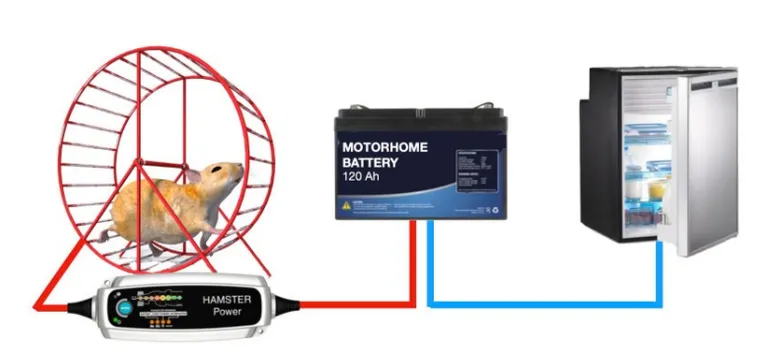
Batteries store electrical energy. Our 12V appliances consume this electrical energy and will continue doing so until no more stored energy remains. Fortunately, the energy supply in our batteries is able to be restored, or recharged. Of course, the big question is: Can our batteries' energy level be recharged at a rate equal to or greater than the rate at which our appliances are consuming the stored energy? Also, how much recharging capacity do we need?
Battery Power
A battery discharges when electrons move from the battery’s negative terminal to the positive terminal and then via the electrical cabling to our appliances, thus powering them. The recharging process uses electrical current to push electrons from the positive side of the battery back to the negative side of the battery via the chemistry in the battery, so they can begin the discharging process all over again.
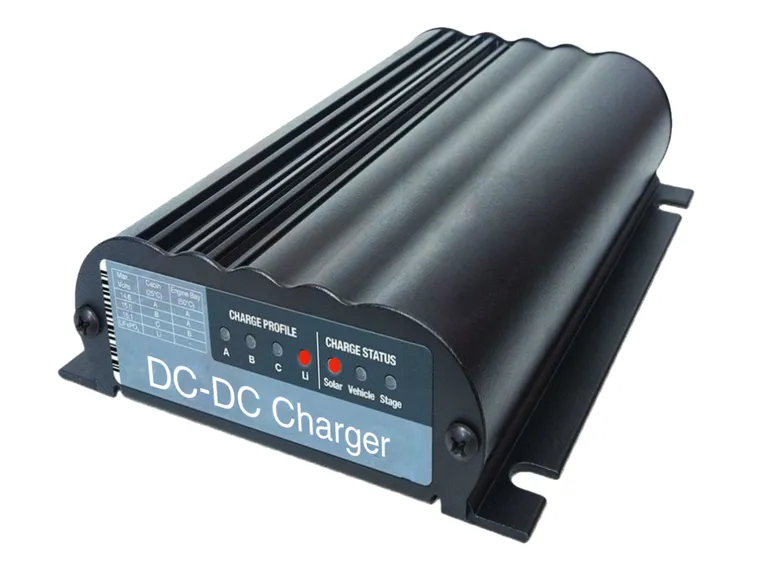
In an RV this recharging process is regulated by a battery charger, using electrical current generated by solar panels, the vehicle’s alternator or a 240-volt power supply. The battery charger measures and regulates the current being fed through to the battery or batteries at a rate that suits their chemistry.
For an AGM (absorbent glass mat) battery, this process can be repeated up to 500 times over its lifetime, while a lithium battery can have the recharging process repeated more than 2000 times. Each full discharge/recharge period is known as a ‘cycle’.
In our previous instalment discussing appliance consumption, we estimated our appliances consume around 70 amp-hours (Ah) of capacity every 24 hours. With this level of energy consumption, 2 x 100 Ah AGM batteries will keep the lights on and the fridge cold for around 35 hours. A similar capacity lithium battery bank will keep the same appliances ticking over for 54 hours, before the flow of electrons is exhausted. These figures reflect the batteries’ ‘base level’ energy capacity and don’t take into account any recharging.
Fortunately, the period of time our batteries are able to maintain a power supply to our appliances can be greatly extended by recharging. Now, take a deep breath, coz here comes some technical stuff….
Recharging AGM Batteries
AGM batteries should be recharged before they reach their 50% discharge level – around 12.1-volts (measured with no load or charging). While discharging of AGM deep cycle batteries below 50% state of charge should be avoided, so too should overcharging. Fortunately, the nuances of this charging process are monitored and managed by our battery charger, charging them in three stages….
• Stage 1 (Boost or Bulk charge): A constant charging current up to 30% of the battery’s rated capacity is provided by the charger until the battery voltage reaches 14.6 V at around 70% of the overall battery charge (up to 4 hours)
• Stage 2 (Absorption charge): Above 70% capacity the current is gradually reduced by the charger, maintaining a constant voltage (around 14.6 V), as the battery’s state of charge (SoC) moves towards maximum charge (up to an additional 6 hours)
• Stage 3 (Float charge): When the battery reaches its fully charged capacity, the charger provides a ‘trickle’ current flow to maintain its optimum operating voltage – around 13.5 V when float charging.
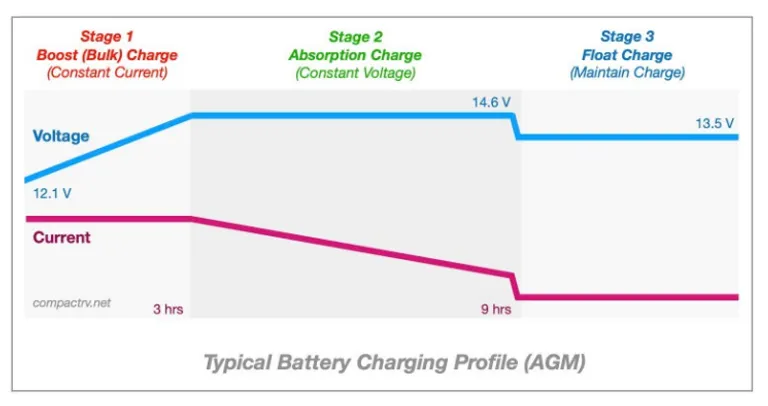
Battery chargers also adjust the voltage supplied to batteries from the charging source. For example, the output from most solar panels is around 18-volts, while the charging input for most AGM batteries is around 14.6-volts. A DC-DC charger adjusts this voltage automatically to protect your batteries, which is why you shouldn’t connect a solar panel directly to your batteries.
Good quality battery chargers with Maximum Power Point Tracking (MPPT) harness this excess solar panel voltage to increase the current available for charging the batteries.
Recharging Lithium Batteries
Lithium batteries require a slightly different charging regime to AGM batteries and a charger must have a specific lithium charging profile to correctly charge them. Essentially, lithium batteries require a two stage charging profile: Boost (Bulk) and Absorption stages, rather than the three stage charging profile of AGM batteries. A lithium charging profile doesn't include a Float stage.
While maintaining a roughly similar charging profile as AGM batteries for the first two stages, lithium batteries are able to charge at a much higher rate in the initial Boost mode – current input may be at up to 100% of the battery’s rated current capacity. In theory, this can result in a much faster recharge time. AGM batteries charging at full current might take three to four hours to process the Boost stage, while a lithium battery can complete the same stage, if charging at full current, in just one hour.
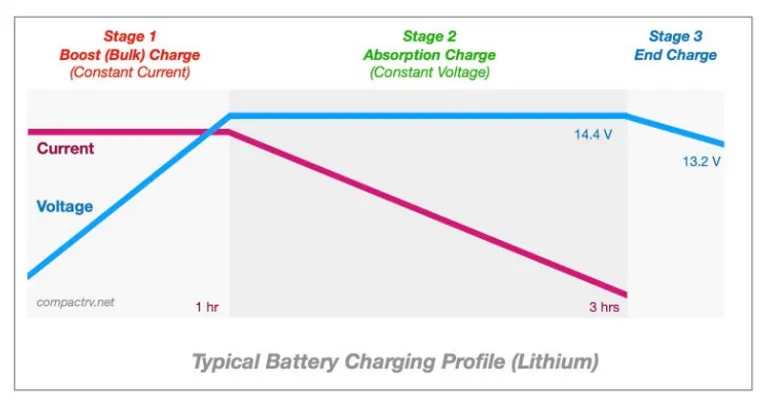
In Absorption mode an AGM battery charging at full current input might take six to eight hours to reach full capacity, while an equivalent size lithium battery can complete this stage in anything from half an hour to two hours – if there is a high enough current feeding into the battery.
The reality though is that the trickle of current feeding in from the solar panels in a motorhome is nowhere near the full current capacity of either an AGM or lithium battery, so we are unlikely to see too much difference in the charging times of both from our solar panels. Experience suggests the lithium recharge time advantage might come into play to some extent when the batteries are being charged from the vehicle alternator (at 40 amps) or the 240V charger (at 25 amps).
With no load, lithium batteries are able to maintain their charge for many months and don’t require a Float stage to compensate for any auto-discharge. In fact, lithium batteries prefer (and will have a longer life-cycle) if charged to 70% when not being used for any length of time, rather than continually being topped up at 100%. So, with all that theory tucked under our hats, how do we actually make it happen with our on-board battery recharging options?
Generating Electricity to Charge Batteries
The three most common options for generating electrical current to recharge motorhome batteries are:
• A solar panel when parked or free camping
• The vehicle’s alternator when driving
• A 240V connection when at home or on a powered site.
All three options provide electrical current that is fed to the battery via a battery charger, which acts as a charging regulator.
Solar panels
The development of solar cells using silicon in the 1950s led to their use to convert sunlight into electrical energy on satellites in the NASA space program. As with many such space-related innovations, the technology has subsequently been commercialised and refined for the betterment of us earth-bound mortals in our free-camping environments.

The solar panels we use in RVs produce up to 18-volts of electricity. This voltage is adjusted by the battery charger to the 14.6-volts preferred by our batteries.
However, when it comes to assessing our battery recharging, we are more interested in the electrical current: How many Amps a solar panel can produce to recharge our (typically) 100 Ah batteries. To make things that little bit more confusing, solar panels are generally rated by their Power output, measured in Watts. If you were paying close attention in those science lessons at school, you will recall that Watts/Volts=Amps. So, a 150 W solar panel operating at 18 V can produce around 8 Amps (per hour) of electrical current. That’s in theory, under ideal conditions.
Given various inefficiencies, let’s assume that in good sunny conditions, we are getting 6 amps of electrical current feeding into our batteries each hour during the day from our 150-watt solar panel. But our fridge is draining up to 2.5 amps of electrical current out of the battery every hour, day and night.
So, while our solar panel is generating 36 amps each 24 hours (6 amps x 6 hours sunshine), our fridge could be draining 60 amps (2.5 amps x 24 hours). Add another 10 amps for other appliances and we have around 70 amps of daily battery drain – 34 amps more than our solar panels are generating.
These are conservative figures. We may be getting 8 hours of solar-generated current, but at 48 amps that still leaves us in a current deficit. From my experience, in summer we are seeing the solar kick in as early as 6 am and stay active until 8 pm. So this might (and that is a big might!) bump it up to 9 hours of charging at 6 amps, or 54 amps for the day. Still a 16 amp deficit.
That’s not a huge problem if we are only staying a few days. We will have enough current feeding into the batteries to keep the lights on and the fridge cold. Starting up the van to move on will push increased current into the batteries from the alternator.

Personally, we have also invested in a portable 200 W solar blanket with a 10-metre lead, for use if camped for an extended period under trees or in other marginal sunlight situations (or just to complement the 150 W rooftop panel for longer off-grid stays). An added benefit of a portable solar panel is that it can be set at a more advantageous angle and continually moved during the day to ‘track the sun’, generating maximum current output.
The electrical current generated by this blanket charges the batteries through our main DC-DC battery charger. It is connected to the electrical system via an Anderson plug installed under the van. This plug is connected to our Redarc 1240D DC-DC battery charger.
With a total 350-watts of solar output available, this can give us up to 15 Amps per hour, or 90 Amps per 6 hour day, which will cover our 70 Amps of daily battery usage (in good theoretical conditions!).
Even with this increased current from the solar panels, both AGM and lithium batteries can take most of the day to fully recharge. The big plus with lithium batteries is that their voltage will continue to be at around 13.2 V all day, while AGM batteries may drop down to 12.2 V, depending on their state of charge.
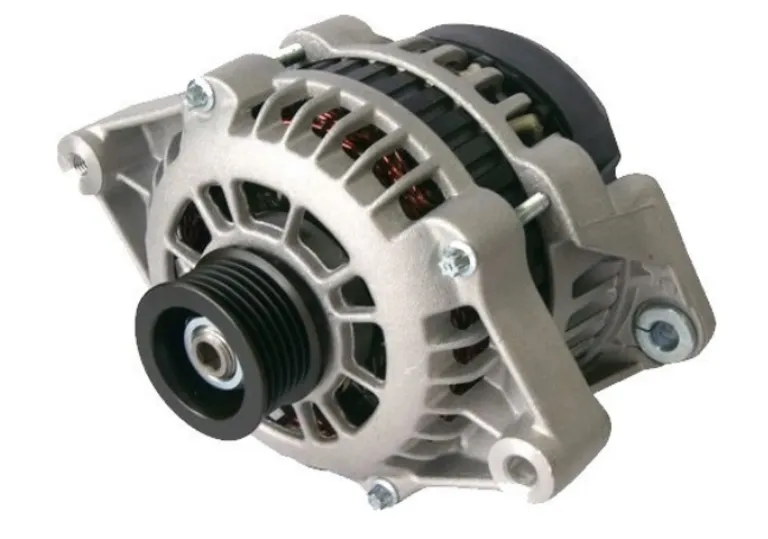
Vehicle Alternator
The current generated by your vehicle’s alternator is used to charge your starting battery and this current can also be used to charge your house batteries. The alternator in our Sprinter can produce up to 60 amps, but how much current feeds to the batteries depends on the capacity of the battery charger/regulator and how it profiles the charging current.
The Redarc BCDC 1240D regulator/charger fitted to our van has a maximum charging capacity of 40 amps per hour. The ammeter in our battery monitor confirms that 40 amps is feeding into our batteries from the alternator, even when the engine is idling. So, driving the vehicle for one hour will (in theory) replenish a maximum of 40 Ah battery capacity, although this may not be the reality at higher charge levels, as the charger tapers the current flowing to the batteries as the batteries’ charge level increases.
However, charging the batteries from the alternator for an hour or so will certainly get you out of trouble and keep your fridge cold if your battery energy level is dipping a little low. The faster rate of charging of lithium batteries with this higher current input is an attractive option that may help to justify their higher up-front cost.
240-volt AC Mains Power
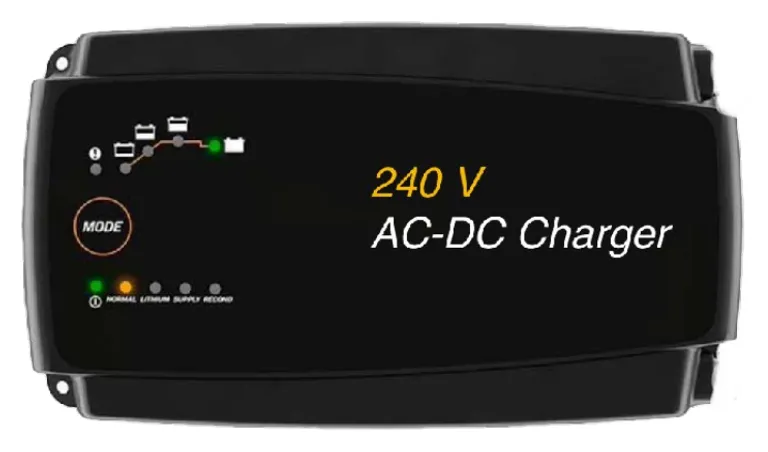
A built-in 240V AC-DC charger is permanently connected to our batteries and will recharge them up to the rate of 25 amps per hour when a 240-volt AC power supply is connected to via the external socket. This current is regulated by the charger in similar stages as the DC-DC charger: Boost, Absorption and Float, for an AGM battery. Remember, if charging lithium batteries, a charger with an appropriate lithium profile should be used.
Lithium Charging Considerations
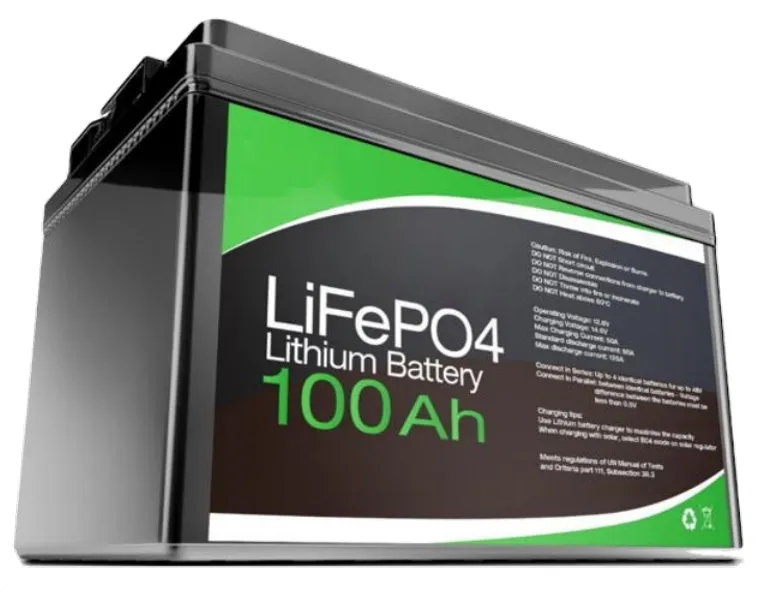
Lithium batteries maintain a more constant voltage output and can be discharged down to 80% capacity. Even when discharged to down around 50%, lithium batteries are still powering appliances at 13.0 V. As seen, they have the potential to recharge more quickly than AGM batteries when higher current input is available from the alternator or mains power.
If you are considering the installation of lithium batteries, make sure that your chargers, both DC-DC and AC-DC, have a lithium charging profile. Most lithium batteries include an electronic battery management system (BMS) built-in that is claimed by suppliers to be able to adapt the output from AGM chargers and modify the profile so that it is suitable for charging lithium batteries. I take these claims with a grain of salt. A BMS may well assist in the charging process in the short term, but my conversations with battery suppliers suggest that a battery charger with a dedicated lithium profile is preferable to the BMS-modified current input, in terms of both general battery performance and long-term battery life.
The Bottom Line
The maths is pretty straightforward: If our appliances are consuming 70 Ah of battery capacity every day and our solar panel is restoring up to 50 Ah of this capacity every day, then we have a deficit of 20 Ah every day. If we have 100 Ah of usable battery capacity then we potentially have 5 days of 12-volt electrical energy for free-camping.
There are plenty of options to extend this time: increasing battery capacity, increasing solar capacity, reducing appliance consumption or simply running the engine to recharge with the alternator.
Which option best suits you depends on how you travel. If you don't stay for more than a couple of nights before moving on then a theoretical five days of free-camping capacity is more than enough. If you are likely to stay on the same unpowered site for weeks at a time, increased solar charging capacity – more panels or a portable blanket – is worthy of consideration.

You do need to keep this all in perspective though: Our 12-volt energy supply is only one factor in the free-camping sustainability equation: Fresh water and cassette toilet capacity are other major considerations. Going crazy with solar panels to recharge batteries might be a moot point if you don't have enough water to last as long as your 12-volt power supply. However, if staying in a National Park with basic toilets and water supply but no mains power connection, for example, a sustainable 12-volt electricity supply is likely all you’ll need for a long term stay.
If your travels find you staying mostly in caravan parks with mains power available and only the occasional night off-grid, then five days of sustainable electrical energy may be a handy fall back, but not really essential. It’s horses for courses, so do your homework and find the right balance that suits. Happy travels!
More information about batteries and recharging options, plus links to related information, is available at CompactRV.net.

